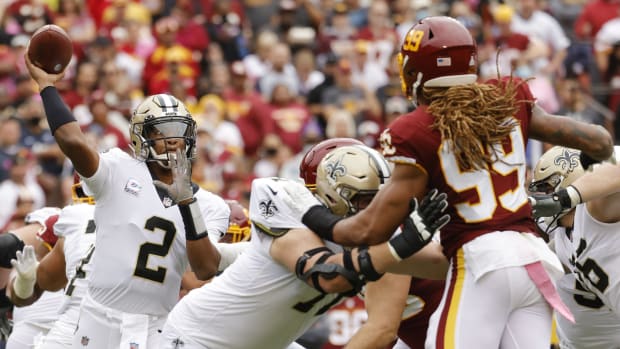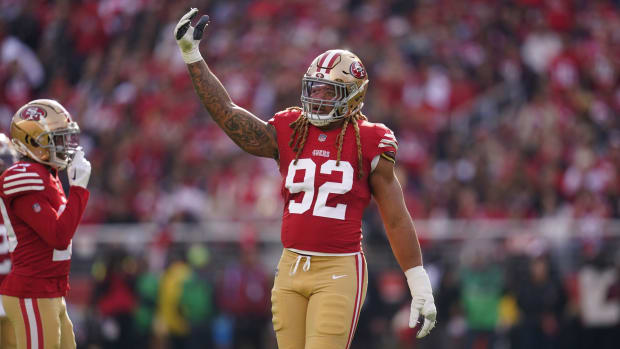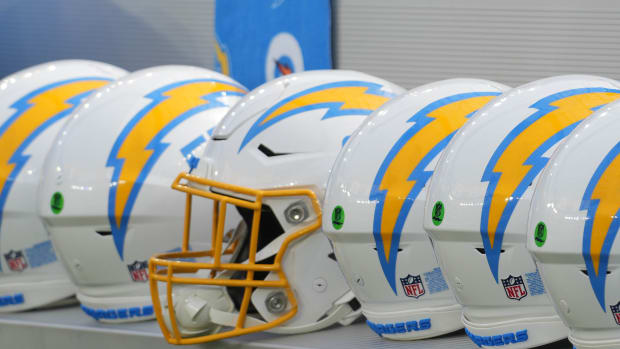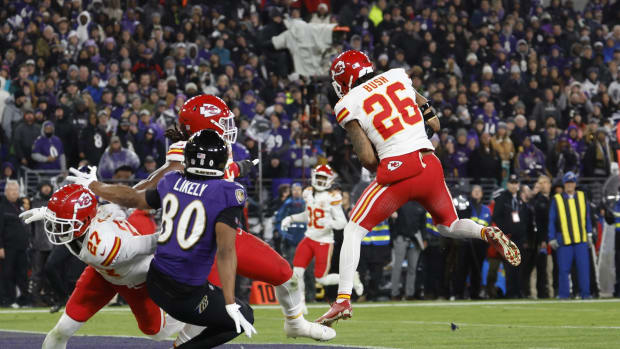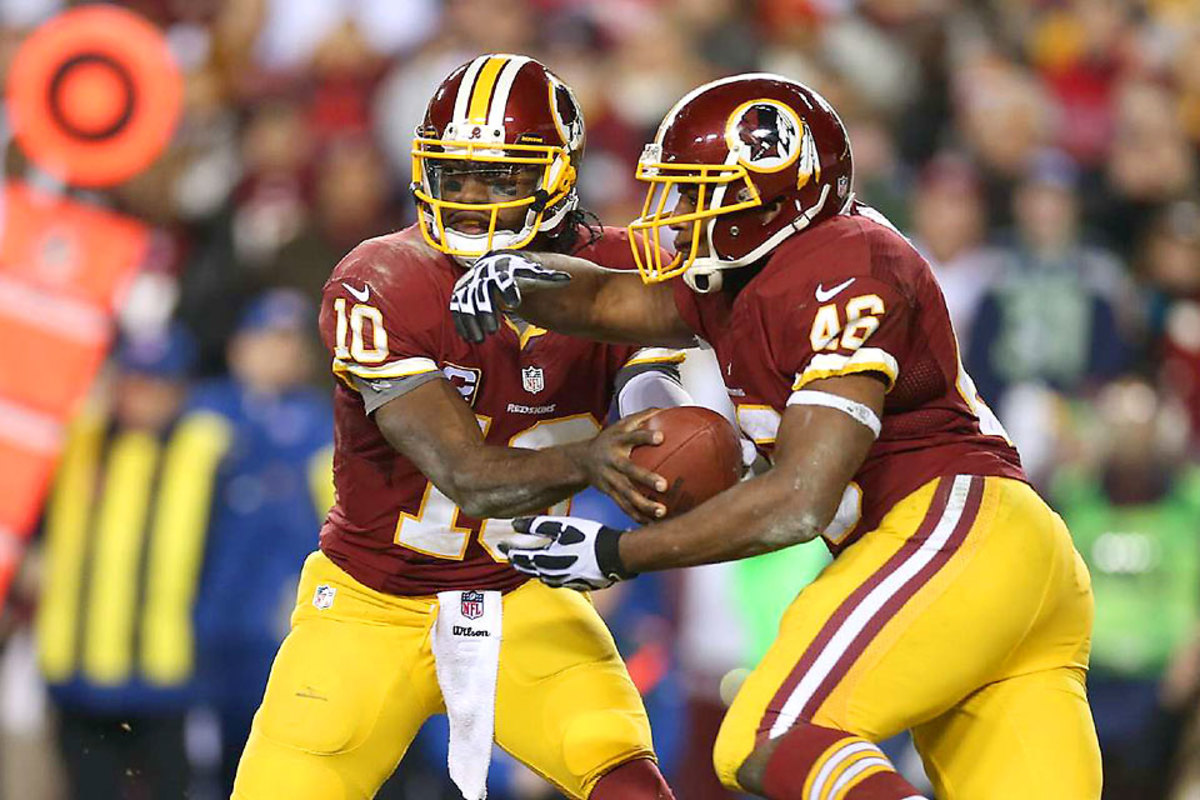
The NFL’s Knowledge Gap
From now until the opening of training camps, The MMQB will run a series of our Greatest Hits from the site’s first year. From July 2013, Greg Bedard on how the rise of the read-option forced NFL coaching staffs to go back to school...
STANFORD, Calif. — After learning the hard way that dual-threat quarterbacks like Colin Kaepernick, Robert Griffin III and Russell Wilson can’t be spied with a linebacker or bull-rushed by an end, defensive coaches across the league went back to school this offseason seeking an enlightenment that would make Aristotle proud.
A few landed at the usual college football factories, like Alabama, Clemson and Texas A&M, looking for a blueprint on how to stop the read-option. But a sizeable cluster sought counsel at an institution better known for addressing problems in fields such as climate change, molecular genetics and computational science. Located in the heart of Silicon Valley, the campus likely has more students with perfect SAT scores than football players who can run a sub 4.4 40. Yet at least a half dozen NFL teams, including the Vikings and Raiders, signed up for a lecture at Stanford.
Across the way from the Graduate School of Business, go up two shiny wooden staircases in the Arrillaga Family Sports Center, turn right at the tree mural, meander through two hallways framed with floor-to-ceiling glass and arrive at the school’s modest football offices. Here sits 43-year-old defensive coordinator Derek Mason, a onetime undersized cornerback at Northern Arizona who still looks like he could take a few nickel snaps. Close the door, dim the lights, fire up the game-film computer program. The professor has a lot to cram in during this two-hour session.
Several NFL coaches sought out Mason (top) this offseason for advice on how to stop the read-option. His defense suffocated top-ranked Oregon last November, after which linebacker Trent Murphy flexed the Cardinal muscle to celebrate their overtime victory. (Nick Ut/AP and John W. McDonough/SI)
Mason doesn’t view himself as an expert on the read-option, but he’s a rising star. In their last two meetings with Oregon before the 2012 season, the Cardinal surrendered 53 and 52 points to Chip Kelly’s high-octane offense. And Stanford barely escaped with a 54-48 overtime victory against Arizona at home last year. It was that narrow win five weeks into the season that forced Mason back to the drawing board, determined to get better.
By the end of the season Stanford led the Pac 12 in scoring defense, total defense, rushing defense, sacks and tackles for loss. The seminal moment was a 17-14 overtime victory in November over No. 1 Oregon. The 10-0 Ducks hadn’t been held under 42 points all season and led the FBS with 54.8 points per game. Their rushing attack averaged 325.1 yards, but the Cardinal held them to 198. The win helped propel Stanford to the Rose Bowl, where it won for the first time in 41 years.
Total number of Stanford defensive players drafted in 2013: zero, same as the year before. So why did so many NFL coaches seek out Mason for advice?
Stanford’s players might not rival Alabama’s in terms of athleticism, but they execute a pro-style, two-gapping 3-4 defense and have football IQs on par with NFL veterans who are trying to adapt to the read-option. What coaches learned from Mason, a Vikings assistant from 2007 to ’09, should make offensive coordinators think twice about letting their thoroughbred QBs run wild this season.
He won’t win a Nobel prize for his work, but as all great teachers do, Mason simplifies the problem to its root cause: Mobile quarterbacks who can throw on the run with the casualness of delivering newspapers create an extra gap that defenses rarely had to account for before last season. Closing it requires a defense that is Stanford to its core: equal parts arts and science.
* * *
The two biggest adjustments being made in professional football will ramp up once the pads are strapped on in training camp. Teams that favor a 4-3 single-gap defense are going to need a backup plan, meaning they’ll have to become a 3-4 team against the read-option. And all edge defenders will need to be retrained, if not brainwashed, on how to play their position.
But before jumping into the Sanskrit of X’s and O’s on Mason’s whiteboard, let’s take a step back and go over a few basics.
A defense letters the gaps in an offensive line. The spaces between the center and both guards are called the A gaps; the B gaps are between the guards and tackles; C gaps are between a tackle and a tight end; and D gaps are just beyond a tight end’s outside shoulder. Most defenders are assigned a gap on every snap. If a defensive tackle shoots the A gap, for instance, a linebacker would take the B. When you hear TV analysts saying a player is being undisciplined, it’s often because he’s chasing the flow of a play instead of minding his gap.
The best defense to stop a traditional running offense is the 3-4. With three down linemen responsible for the interior and two outside linebackers covering the edges, all the gaps are covered. The two inside linebackers react to the flow of a play and help form a wall, meaning a properly defensed running play should yield no room for a back to break through the line of scrimmage.
“If you’re playing single-gap defense, you’re going to be one gap short every time,” Mason says, pausing at the whiteboard and turning around to make sure this important point is understood.
In a single-gap scheme, often a 4-3, a lineman is tasked with clogging one hole and making a tackle if the ballcarrier comes his way. In a two-gap scheme, often a 3-4, he’s responsible for the gap on either his left or right. His main job is to engage blockers so the linebackers behind him can make tackles. The 3-4 alone won’t stop the read-option, because it creates an extra gap, but it allows for the easiest adjustment.
Against a pocket passer in a traditional offense, gap responsibility stops at D. And the defense has the upper hand in such matchups, essentially playing 11 against 10 because the quarterback isn’t a threat to run. But when you introduce a QB who has the ability to fake an inside handoff and then scoot around the weak end of the defense, the E gap is created in an area that is typically left unguarded. The game now becomes 11-on-11, the new math of the NFL.
Our goal is to stop the run and defend the pass. You can’t stop everything. But if they can run, that sets up the play-action pass, and they’re rolling at that point. That’s what they want.
Mason starts rolling film of Oregon against another opponent. From their split-back pistol set, the Ducks run a play similar to the ones Kaepernick used to victimize the Packers in the 49ers’ 45-31 divisional-round win in January. In that game Green Bay surrendered a season-high 579 yards of total offense, including an eye-popping 323 on the ground. Kaepernick himself rushed for 181 yards, the most by a quarterback in an NFL game and more than 14 other teams’ total against the Packers in 2012.
Oregon quarterback Marcus Mariota fakes a handoff to the running back on a dive, then rolls to his right with De’Anthony Thomas in the triple option. A defender gets a wicked shot on Mariota, but only after he delivers the pitch to Thomas, who scampers nearly 40 yards for a touchdown.
“What do you see, just in terms of numbers?” Mason asks.
“The defense is one short on the outside?” his visitor says.
“That’s right,” Mason says. “They actually wound up with two guys on the quarterback and nobody on the pitch.”
Pointing to a defensive back in the slot, Mason adds, “This guy has no business squeezing down on the quarterback. That’s not his play. He’s really the pitch guy.”
But the defensive back isn’t the only one to blame. The left outside and inside linebackers both entered the same gap. One of the two should have taken the quarterback, but the outside backer crashed down and the inside backer failed to use the scrape technique (moving laterally to cover for the outsider backer when he shoots inside.) When two linebackers blow up the same gap, it’s a recipe for disaster. The slot defender has to jump into the D gap, which leaves the E gap vacant. Thomas ran through this alley to find open field—the same floodgate that sprung Kaepernick, RG3 and Wilson into NFL secondaries last season.
* * *
Will he turn the corner and keep going, or will he pull up and throw? Defenses will have to become more vanilla in pass coverage in order to keep an eye on mobile QBs like Wilson. (John W. McDonough/SI)
The first thing a read-option quarterback looks for when he gets to the line of scrimmage is to see if the defense has left itself short somewhere. That is, is the E gap being accounted for? The easiest way to take away the E gap is to play a 3-4 (because everything else is covered) and rotate a safety into the area that would normally be unguarded. But it’s not a perfect solution. This forces a defense to become more vanilla in its pass coverage, because a lone safety lined up deep doesn’t allow for convincing presnap disguises.
Most of the Packers’ blown yardage in that playoff game against the 49ers came when they were employing man coverage with help from two safeties over the top. In this schematic wrinkle, cornerbacks position themselves as close to receivers as possible while staying between the quarterback and his target. This, however, requires them to play with their backs to the line of scrimmage, which might as well be a Bat-Signal for QBs like Kaepernick to take off running.
By watching film of college teams, and that of the Steelers—Pittsburgh held Griffin and the Redskins to a regular season-low 255 yards of total offense in its 27-12 victory last October—you quickly realize that defenses should play the percentages when defending the pass ... and hope the quarterback has moments of inaccuracy.
Pick your poison: Kaepernick stood in the pocket and threw for 221 yards and four TDs, including strikes of 38, 34 and 24 yards, against the Pats on Dec. 16. Nearly a month later he set the NFL record for rushing yards by a QB (181) in a playoff win over the Packers. (Damian Strohmeyer/SI and John W. McDonough/SI)
To account for the quarterback as a runner, defenses should play mostly quarters (facing the play, two corners and two safeties are each responsible for one of four vertical columns in the secondary) or single high safety, with the other safety providing run support. The latter leaves defenses susceptible to deep shots, which the Patriots learned against the 49ers last December. Trying to attack the E gap isn’t new in football—think of a naked bootleg around the weak side—but what makes the read-option so groundbreaking is that it’s being orchestrated by quarterbacks who can throw as well as they run. Pure option quarterbacks have never thrived in the NFL, but when Kaepernick throws the deep ball with accuracy, the 49ers are virtually unstoppable. As a defensive coordinator you need to pick your battles.
“Our goal is to stop the run and defend the pass,” Mason explains. “You can’t stop everything. But if they can run, that sets up the play-action pass, and they’re rolling at that point. That’s what they want.”
The read-option not only limits a defense’s coverage, it deflates the pass rush as well. Players who predominantly line up with a hand on the ground in a 4-3 will now be drilled to use a two-point stance (that is, to stand up). They’ll be instructed to read and react to a developing play instead of going straight for the quarterback—a tactic that allows them to crush pocket passers, but one that makes them look like bystanders as read-option QBs react to their impulsive moves.
Mason, whose arm seems to be surgically attached to the dry-erase marker, draws a straight line signifying an instant rush from a defensive end—the unblocked one opposite the tight end side of the formation—to the quarterback. If the unblocked end charges in this fashion, and if you don’t have an inside linebacker or safety moving into the vacated gap, good luck stopping the read-option.
This hard-charging end is left unblocked for a reason. He’s like a basketball player trying to defend a pick-and-roll by himself. In other words, he’s powerless. If he comes at the quarterback, the running back takes the handoff. If the end angles his shoulders toward the dive back, the QB pulls the ball back from the handoff (also called the mesh point) and takes off around the corner, forcing the end to turn back and give chase.
Mason depicts a solution on the whiteboard, showing the unblocked end first going upfield, at no one, and then squeezing down on the running back once he gets the ball. The idea is to let the quarterback make a decision without giving him all the information he wants.
“The quarterback wants a fast read all the time,” Mason says. “If you don’t give him a fast read, then things start to break down and he starts to panic because everything is predicated on him being able to make a fast read. Especially in the NFL, because they don’t want to get that guy hit. If you come up the field and then try to squeeze, it’s now hard on the quarterback.”
* * *
A slow read forces the quarterback to think more. In football, thinking equals slow, and slow equals disaster. Slowing down the read won’t just stop the quarterback, it’s also important in wrapping up the running back. A week after running roughshod over the Packers, Kaepernick was held to 21 yards on two carries by the Falcons in the NFC title game. But the 49ers still advanced to Super Bowl XLVII with a 28-24 victory because tailback Frank Gore had 90 yards on 21 carries and scored the game’s final two touchdowns.
On each of Gore’s TDs, the Falcons attacked Kaepernick but didn’t have anyone covering the inside gap. Thanks to strong play from the offensive line, Gore was able to slip through. Atlanta kept Kaepernick in check, but the read-option isn’t solely about the quarterback. There’s a reason why Alfred Morris, a sixth-round rookie out of Florida Atlantic, finished second in the league in rushing with 1,613 yards playing alongside RG3. Read-option offenses don’t care for whom the gap is opened—they’re going to exploit what you give them.
Going after the quarterback won't stop the read-option; defenses have to fill every gap. With just over eight minutes to play in the fourth quarter of the NFC championship game, Gore scored the game-winning TD virtually untouched from nine yards out. Falcons defensive end John Abraham tried to contain Kaepernick, but turned into a bystander. (Top sequence courtesy of NFL Rewind; John Amis/EPA)
Not surprisingly, the Packers and Falcons both took courses on college campuses (Green Bay went to Texas A&M and Atlanta to Clemson). Even so, defenses across the league might still be a step behind. At the college level, Mason has seen offensive coordinators using faster tempos by going no-huddle, and they’re creating ways to make reads off interior defensive lineman, not just edge players. Offensive coordinators in the NFL might use as many as 15 formations with the same personnel grouping in a game, but a defense isn’t going to have as many schemes to confuse an offense. Stopping the read-option is about knowing how and where to line up, and being on the same page about how to attack the formation. One blown gap and Kaepernick is sprinting 60 yards for a touchdown.
“There’s no magic elixir playing against those schemes,” Mason says. “It’s being fundamentally sound in terms of your keys. That’s it. If you don’t understand your fits, or where your eyes go and where your help is, you’re at risk. You’re just out there playing ball, and they’re always going to be one step ahead of you.”
And with that, Mason wipes the whiteboard clear. Can’t give away all the secrets.
NFL defenses often looked foolish against the read-option last season. Their biggest problem was rooted in surprise. Robert Griffin III and Russell Wilson were rookies, and Colin Kaepernick, a second-year pro, didn’t become the starter until Week 11. Once a season begins, there isn’t much time for a defense to properly study and adapt to a previously unknown scheme. Even if there was, it would have been impossible to re-program 4-3 defensive linemen (the single-gap players) who make a living getting upfield and wreaking havoc as quickly as possible.
Going into a new season, defensive coaches have had months to take lecture notes from college coaches like Mason and become teachers themselves. Expect any 4-3 team that plays against a read-option offense in 2013 to employ modified version of a 3-4, two-gapping scheme.
Mason may know how to slow the read-option, but the best advice comes from a different Stanford classroom. Across the Oval and Main Quad, where they teach applied physics, you’ll be reminded that “for every action there is an equal and opposite reaction.”
NFL defenses have taken action, and offenses will soon react. Whoever studied the best this offseason will ace the test. The loser will have to enroll in summer school again.
Peter King caught up with two of last season's biggest read-option stars, Colin Kaepernick and Russell Wilson. See what both are up to, and what both are thinking as a new season looms.




































